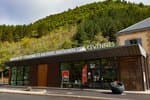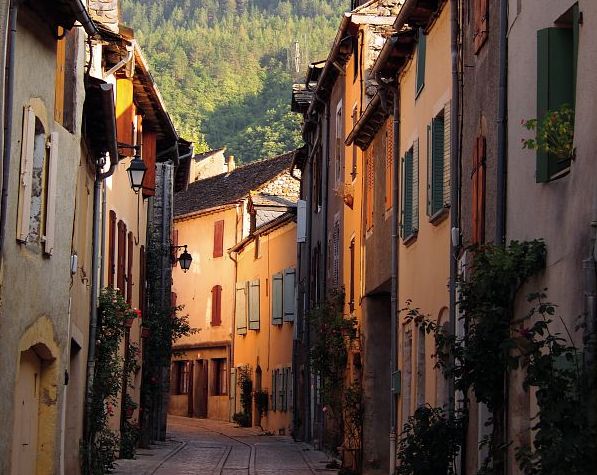
The gardens of Ispagnac (by mountain-bike)
4 points of interest
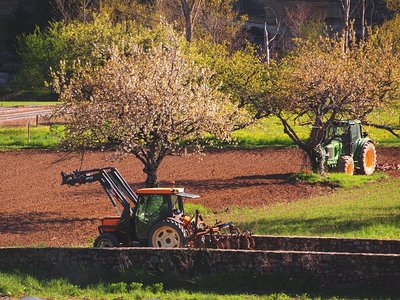
Vergers d'Ispagnac - © Francis Fayet AgricultureThe gardens of Ispagnac
Ispagnac is in the contact zone of limestone, granite and schist bedrock. The valley of Ispagnac is irrigated by the river Tarn and, being protected from the north and north-western winds, it enjoys an almost southern climate. This has earned it the nickname of “garden of the Lozère”. A market gardener and two wine-makers are based here.
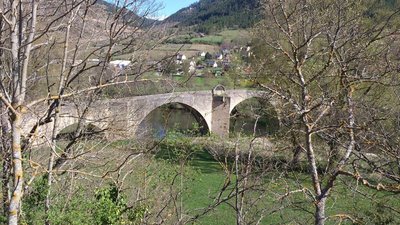
Pont de Quézac - © CC Florac Sud Lozère  Architecture
ArchitectureQuézac Bridge
This bridge crossing the river Tarn gives access to the village of Quézac, located on the left bank. Around 1350, Pope Urban V decided to fund its construction to facilitate pilgrims' access to the collegiate church of Notre-Dame de Quézac. It was finished in the 15th century. Its history is punctuated by partial destruction in floods, and by more or less solid rebuilding. It became a listed monument on 27 August 1931.
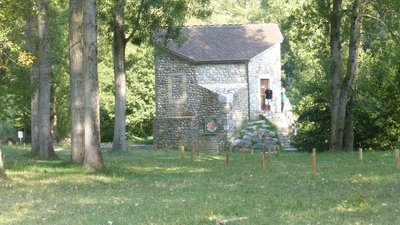
Source de Quézac - © Nathalie Thomas  Water
WaterQuézac mineral water
Quézac mineral water emerges naturally from the Diva spring, near the entrance to the village, in exceptional surroundings which have been naturally protected for centuries. This pleasant-tasting water is rich in mineral salts and trace elements and is also well-known to be beneficial for the stomach. The spring's water actually comes from Mont Aigoual. According to scientific studies, it takes 30 to 40 years for it to re-emerge in Quézac, after first settling in aquifers, where it acquires its effervescence naturally (rare in France).
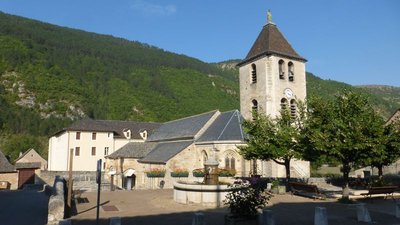
Notre-dame de Quézac - © Nathalie Thomas  History
HistoryNotre-Dame de Quézac
The collegiate church of Quézac – today Notre-Dame church – was fortified in the 14th century at the instigation of Pope Urban V. The first building is believed to have been erected in 1052 in honour of Our Lady of Quézac. Legend has it that a ploughman found a black Virgin while ploughing a furrow, which he brought into the church. However, it disappeared during the night, and the next day was found again in the furrow. The decision was taken to build an oratory on the spot chosen by the Virgin, and soon large numbers of pilgrims on their way to Santiago de Compostella visited Quézac. Today, a stained-glass window illustrates the dedication of the collegiate church to Our Lady.
Description
Mountain-bike route #3. This route uses small tarred lanes and good tracks, and includes one slightly more technical downhill section. From the car park opposite the pharmacy, cycle down to the Tarn via the town gardens. Go along the river to Quézac Bridge. Cross it and go through Quézac. Turn right to get to the village gardens. Go back up to the town hall (mairie) and over the bridge. Immediately after the bridge, turn left to join up with the D 907 bis, onto which you turn right for a few metres before turning left above Ipagnac. Go through the vineyards and return to the village through the recently built part of town.
- Departure : Ispagnac
- Arrival : Ispagnac
- Towns crossed : Ispagnac and Gorges du Tarn Causses
Forecast
Altimetric profile
Information desks
Tourism office Cévennes Gorges du Tarn, Ispagnac
Place de l'Église, 48320 Ispagnac
This office is part of the National Park's associated tourist-information network, whose mission is to provide information on, and raise awareness of, the sites and events as well as the rules that must be observed in the National Park's central zone.
Open year-round
Tourism'house and national Parc at Florac
Place de l'ancienne gare, N106, 48400 Florac-trois-rivières
This office is part of the National Park's associated tourist-information network, whose mission is to provide information on, and raise awareness of, the sites and events as well as the rules that must be observed in the National Park's central zone.
On site: exhibitions, video projections, events and shop Open year-round
Transport
- Bus line 258 “Florac – Sainte-Enimie – Le Rozier”, every day in July and August.
Access and parking
From Florac, take the N 106 towards Mende, then fork off onto the D 907 bis towards Molines, Ispagnac, Ste Enimie
Parking :
Calculateur d'itinéraire Lio
Utilisez le calculateur liO pour organiser votre trajet en région Occitanie.
Autres régions
Calculez votre itinéraire en Auvergne Rhône Alpes sur Oùra
Biodiversité autour de l'itinéraire
Source


Report a problem or an error
If you have found an error on this page or if you have noticed any problems during your hike, please report them to us here:


